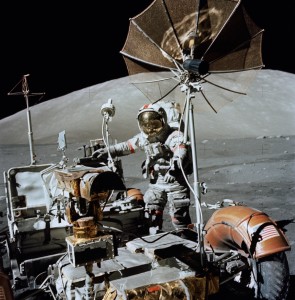
NASA / Apollo 17: photo by Harrison Schmitt of the lunar rover and Cmdr. Gene Cernan
4 January 2016 – Every Christmas/New Years holiday period my wife and I jaunt off somewhere and I shove into my carry-on a sheaf of science clippings I had not managed to read over the past year. A few were by one of my favorite science writers (who is also a theoretical astrophysicist), Ethan Siegel.
One thing I learned from Siegel’s writings is that one of the most exciting phrases to hear in science is not “eureka!” but “that’s funny,” and the Apollo 17 astronauts, just over 43 years ago, certainly got such a moment when they discovered orange soil just beneath the grey regiolith. What turned out to be volcanic glass with tin inclusions had another surprise: olivine deposits that showed signs that they contained significant amounts of water inclusions when they were baked, at about ~1200 parts-per-million. This matches the water levels in Earth’s upper mantle along ocean ridges, providing further evidence for the giant impact hypothesis and a common origin for the Earth and Moon.
In all of human history, only 24 people have flown to the Moon, with 12 walking on the lunar surface. The final two, Gene Cernan and Harrison Schmitt, ran into quite a surprise. Schmitt, the lone civilian-astronaut (and only scientist) to travel to the Moon, was often described as the most business-like of all the astronauts. Which is why it must have been such a shock to hear him exclaim the following:
Oh, hey! Wait a minute… there is orange soil! It’s all over! I stirred it up with my feet!
Over the decades after the Apollo missions concluded, technology continued to advance. In 2011, a team was able to analyze the samples that Schmitt and Cernan brought back, and found something spectacular: evidence that water was included during this volcanic eruption.
As Siegel notes “it’s arguable that all of this wouldn’t have come to pass — that we never would have learned any of this — if we hadn’t sent a human scientist to the Moon who knew when to look more closely at what was beneath their feet.”
For the full article click here.